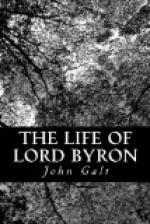In carrying this arrangement into effect, I was induced to go aside from the direct route, and to visit Velhi Pasha, at Tripolizza, to whom I had letters. Returning by Argos and Corinth, I crossed the isthmus, and taking the road by Megara, reached Athens on the 20th of February. In the course of this journey, I heard of two English travellers being in the city; and on reaching the convent of the Propaganda, where I had been advised to take up my lodgings, the friar in charge of the house informed me of their names. Next morning, Mr Hobhouse, having heard of my arrival, kindly called on me, and I accompanied him to Lord Byron, who then lodged with the widow of a Greek, who had been British Consul. She was, I believe, a respectable person, with several daughters; one of whom has been rendered more famous by his Lordship’s verses than her degree of beauty deserved. She was a pale and pensive-looking girl, with regular Grecian features. Whether he really cherished any sincere attachment to her I much doubt. I believe his passion was equally innocent and poetical, though he spoke of buying her from her mother. It was to this damsel that he addressed the stanzas beginning,
Maid of Athens, ere we part,
Give, oh! give me back my heart.
CHAPTER XIX
Occupation at Athens—Mount Pentilicus—We descend into the Caverns— Return to Athens—A Greek Contract of Marriage—Various Athenian and Albanian Superstitions—Effect of their Impression on the Genius of the Poet
During his residence at Athens, Lord Byron made almost daily excursions on horseback, chiefly for exercise and to see the localities of celebrated spots. He affected to have no taste for the arts, and he certainly took but little pleasure in the examination of the ruins.
The marble quarry of Mount Pentilicus, from which the materials for the temples and principal edifices of Athens are supposed to have been brought, was, in those days, one of the regular staple curiosities of Greece. This quarry is a vast excavation in the side of the hill; a drapery of woodbine hangs like the festoons of a curtain over the entrance; the effect of which, seen from the outside, is really worth looking at, but not worth the trouble of riding three hours over a road of rude and rough fragments to see: the interior is like that of any other cavern. To this place I one day was induced to accompany the two travellers.
We halted at a monastery close by the foot of the mountain, where we procured a guide, and ate a repast of olives and fried eggs. Dr Chandler says that the monks, or caloyers, of this convent are summoned to prayers by a tune which is played on a piece of an iron hoop; and, on the outside of the church, we certainly saw a piece of crooked iron suspended. When struck, it uttered a bell-like sound, by which the hour of prayer was announced. What sort of tune could be played on such an instrument the doctor has judiciously left his readers to imagine.




